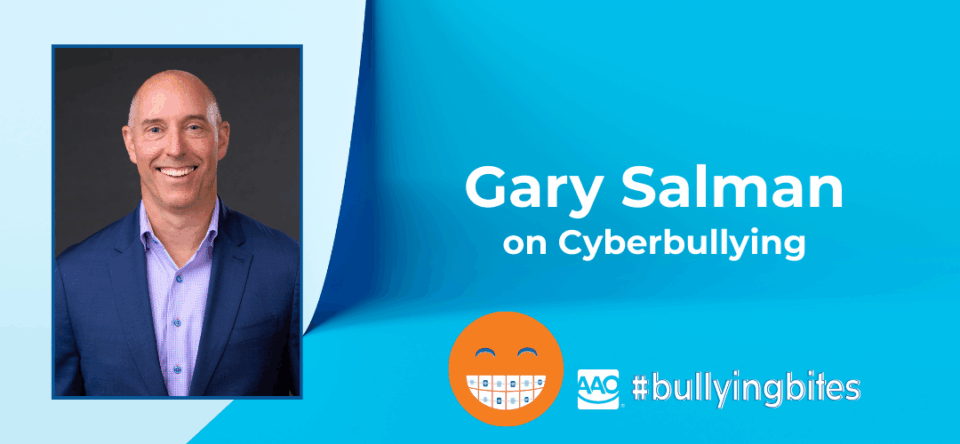by Gary Salman, CEO and Co-Founder of Black Talon Security
As an orthodontist, you see more than just teeth; you see the whole person behind the smile. And because you see patients over an extended period, you may be able to notice changes in their demeanor and behavior. In today’s digital world, many adolescents face a hidden threat. Research shows that 46% of teens have experienced cyberbullying in various forms. Bullying often targets appearance, and in fact, teeth are a common physical feature that bullies single out. This means your patients may be especially vulnerable online.
In this article, we’ll explore common forms of cyberbullying, where it happens, warning signs you might notice in your patients, and how you can help. With a warm conversation and the right resources, you can play a small but important role in protecting your patients’ mental well-being while you straighten their smiles.
On a personal note, I was involved in a case where extreme cyberbullying and extortion against a 15-year-old male resulted in an attempted suicide. The victim had been lured online by someone who he thought was a 15-year-old female. The “female friend” convinced him to send partially naked photos to himself. After receiving the photos, the “friend” turned into an “attacker” and started posting harassing messages and photographs of the victim on Instagram. His friends were tagged in the post, and he became the target of cyberbullying at school.
The posts quickly turned to extortion. The victim came from a wealthy family and the attacker demanded $1,000 in bitcoin to “go away.” Eventually the victim came up with the money and paid the attacker. Unfortunately, the mental anguish did not stop. The victim attempted suicide and was found on the floor by his mother. He refused to talk to his family or the police for over a month and basically locked himself in his room and refused to interact with anyone. Cyberbullying and extortion have real-world consequences, and my heart goes out to these victims. As an orthodontist, you may be able to make a difference in a child’s life by picking up on indicators of cyberbullying through conversation and observation.
Understanding Forms of Cyberbullying
Cyberbullying isn’t one-size-fits-all — it comes in many malicious forms. Being familiar with these can help you recognize if a patient might be affected. Common forms include:
Harassment: Repeatedly sending offensive, hurtful, or threatening messages online. This could mean texts, direct messages (DMs), edited photographs, or comments that relentlessly target a victim.
Impersonation (Masquerading): Creating a fake profile or posing as someone else (sometimes even as the victim) to post damaging content. For example, a bully might steal a teen’s photo to make a fake account and tarnish their reputation.
Exclusion: Deliberately leaving someone out of online groups, chats, or events. Today’s social lives often revolve around group chats and Snapchat or Instagram stories — being “left on read” or kicked from a group can be an intentional form of bullying.
Doxxing: Publicly revealing someone’s private personal information (like address, phone number, or secrets) without consent. The aim is to embarrass or harm the victim.
Trolling: Posting inflammatory or off-topic messages to provoke and upset someone. For instance, a “troll” might leave nasty comments on a teen’s TikTok video just to spark conflict.
Cyberstalking: Using technology to relentlessly harass or intimidate someone, often with threats or monitoring of the victim’s online activity. This is an extreme form of cyberbullying — in fact, serious cyberstalking is a crime in the United States.
Image-Based Abuse: Sharing or threatening to share private or embarrassing images/videos of someone without consent. A cruel trend among teens is to circulate a photo of a classmate’s face (or smile) with insulting captions. In more severe cases, this includes “revenge porn” or any non-consensual sharing of intimate images.
Understanding these tactics helps orthodontists grasp what their patients might be up against online. Even seemingly harmless teasing about “brace face,” or a selfie gone wrong can rapidly escalate when it’s digital and viral.
Where Cyberbullying Happens: Key Platforms
Cyberbullying can occur anywhere kids connect digitally. However, certain apps and platforms are hotspots for teen interactions – and thus for bullying. A few to be aware of include:
Social Media Platforms (TikTok, Instagram, Snapchat): These popular apps can expose teens to different forms of bullying, including mean or mocking comments on videos, hurtful viral “challenges,” fake accounts impersonating them, exclusion from tags or invites, and disappearing cruel messages or images. The temporary or public nature of posts can make the impact feel sharper and, at times, embolden bullies.
Discord and Online Gaming Chats: Many teens (especially boys) use Discord, Xbox/PlayStation chat, or other gaming platforms to talk while gaming. Trash-talk is common – and sometimes it crosses into real harassment or group pile-ons in voice or text chat.
Anonymous Q&A Apps or “Finstas”: Apps like Ask.fm or anonymous messaging features, and fake Instagram accounts (“Finstas”), let people bully behind a mask of anonymity. For example, a teen might receive anonymous messages like “Nobody likes your ugly teeth,” which can be devastating.
Texting and Group Chats: Even plain old texting (or group texts on WhatsApp, iMessage, etc.) can be a venue for bullying — spreading rumors, excluding someone from group messages, or creating group chats specifically to taunt one person.
Keep in mind that new apps emerge often. The content of cyberbullying — such as mean words, embarrassing pictures, social isolation — tends to be similar across platforms, even if the app names change. What’s important is that these digital spaces are an extension of your patients’ social lives. Just as bullying can happen in the school halls, it can happen on a smartphone under the dental chair.
The more you know about where kids spend time online, the better you can understand their world (for instance, knowing that a lot of disappearing-message apps exist means a patient’s claim “I have no proof, the messages delete” is quite plausible.
Warning Signs: Is Your Patient a Cyberbullying Victim?
How can you, as an orthodontist, tell if a normally bubbly 13-year-old patient is secretly dealing with cruel messages or social media shaming? You’re not a counselor, but you do see these kids regularly, often over 1–2 years of treatment. That puts you in a good position to spot red flags.
Here are some behavioral and emotional signs of cyberbullying that might surface during routine visits:
Anxiety or Nervousness: A teen patient looking withdrawn or anxious, especially when holding their phone, could be showing signs of cyberbullying. The patient appears unusually anxious during their appointment — especially if their phone buzzes. For example, a teen might flinch or look worried every time a notification comes in. Many victims appear nervous or jumpy when using their device(s) because they fear the next cruel message.
Withdrawn or Sad Demeanor: You might notice a normally chatty teen has become quiet and withdrawn. They could seem downcast, with little enthusiasm for things they used to enjoy (like talking about sports or school events). Bullying often leads to depression, social isolation, and low self-esteem in youth. A patient who is being cyberbullied may sit slumped in your chair, avoid eye contact, or only give one-word answers, which can signal that something’s weighing on them.
Avoidance of Photos or Mirrors: If a patient refuses to look at their teeth in the mirror or shies away from taking progress pictures (like those fun braces removal photos), consider it a possible sign. Some teens who’ve been body-shamed or ridiculed about their looks online start avoiding selfies and photos altogether. For instance, a patient might joke, “I don’t do selfies anymore” in a bitter tone — which could hint that someone online made them feel insecure about their appearance. Given that bullies often target dental features, a teen might be hyper self-conscious about their smile or braces if they’ve been teased.
Changes in Behavior or Health: Pay attention to any mention of new habits: “Not sleeping well lately,” frequent headaches or stomach aches, or a parent mentioning “She hasn’t been eating much.” Stress from bullying can manifest in physical symptoms like headaches, stomachaches, or disrupted sleep. A cyberbullied teen might also start faking illnesses to skip school or orthodontic appointments — any situation that might bring them face-to-face with peers. If a usually punctual patient is now often asking to reschedule or showing reluctance to go to school (maybe a parent mentions, “He begs to stay home on adjustment days that overlap with school gym class”), it could be a sign of bullying-related school avoidance.
Low Self-Esteem and Negative Talk: Listen for self-critical comments like, “My smile is so ugly,” “My teeth make me look stupid,” or general hopeless statements. Kids being bullied often feel helpless and blame themselves. If a patient makes passing statements about feeling worthless or life being meaningless, that’s a big red flag – whether related to bullying or not. Even milder comments like “I’m just ugly, braces won’t fix that” indicate their confidence has taken a hit. Bullies thrive on destroying self-esteem, so a sharp drop in a teen’s confidence or an increase in self-deprecating humor is cause for concern.
Important: No single sign confirms cyberbullying — any of the above could have other causes (normal teen mood swings, other stress at home, etc.). But multiple signs or a significant change from a patient’s usual behavior warrant a closer look. Not all kids who are bullied will ask for help, so gentle investigation is key.
How Orthodontists Can Help: Best Practices for Intervention
You might wonder, “Is it really my place to get involved in a patient’s personal issues?” Of course, you’re not expected to be a bullying expert or therapist. But if you suspect a patient is suffering, there are a few simple, supportive actions you can take within your role:
Create a Safe, Gentle Conversation: Start by opening the door. Something as simple as, “You seem a bit down today — everything okay?” can let a teen know you care. A little empathy can go a long way. Ask open-ended, casual questions: “How’s school going?” or “What fun stuff are you into lately — any new apps or games?”. If the patient hints at problems (e.g., “School’s been rough lately.”) gently probe: “I’m sorry to hear that. Rough how?”
Keep Your Tone Supportive, Not Interrogative: Often just giving a young person a chance to talk — and really listening — is the most powerful help you can offer. Remember to stay calm and validating. If they disclose they’ve been bullied, praise them for telling you and reassure them they’re not alone and do not deserve this treatment.
Loop in Parents—Carefully: Notifying parents is crucial but do so in a way that doesn’t betray the teen’s trust. Depending on the situation, you might encourage the patient to talk to their parents: “This sounds like something your mom or dad would want to help you with. Would you feel okay if we brought them into this conversation?” If the teen is very resistant or the situation seems urgent (e.g., signs of self-harm or severe depression), you may need to inform the parent yourself after the appointment. Approach the parent privately and share observations in a concerned, factual way: “I’ve noticed Jamie has been really quiet and mentioned not wanting to go to school. I’m not sure if you were aware, but I’m a bit worried he might be experiencing bullying online.” As a healthcare provider, you have a duty to the child’s wellbeing, and parents should be partners in addressing the issue. Most parents would rather know than be left in the dark — even if it’s a tough conversation.
Provide Reassurance and Practical Advice: Orthodontists can offer a unique form of encouragement, especially if the bullying centers on the child’s appearance. If a patient is teased about their teeth, remind them (and their parents) that braces are a positive step — they’re proactively improving their smile. You might say, “I know kids can be mean about teeth. Just remember, the braces are temporary, and the end result will be great — plus, a lot of people think braces are pretty cool these days!” (Indeed, braces have lost much of their old stigma.)
For Bullying in General, Advise the Basics: Don’t respond in anger to bullies (it often fuels the fire), save evidence of cyberbullying (screenshots of messages or posts), and use privacy tools (block or mute the bully online, tighten account settings). While this isn’t your primary job, sharing a quick tip like “Have you blocked that person?” or “You might want to take screenshots in case you need to report it” can be very helpful and shows the patient you’re on their side.
Know When to Refer to Professionals: Sometimes bullying can lead to issues way beyond a teen’s coping capacity — or yours. If you suspect serious depression, trauma, or any hint of self-harm, encourage the family to seek professional mental health support. You can say, “There are counselors who specialize in helping teens get through things like this. It might help to talk to one.” In the United States, you could mention that if a child is “acting differently than normal, always sad or anxious,” connecting with a counselor or mental health service is recommended. Provide parents with referrals if you have them (perhaps your network includes a friendly child psychologist, or simply suggest they speak with the child’s pediatrician or school counselor).
Take Action in Emergencies: If you ever believe a child is in immediate danger (e.g., threats of suicide or violence), that’s an emergency — don’t hesitate to call 911 or follow local mandated-reporter protocols. Thankfully, such extreme cases are rare, but being prepared is key.
Follow Up: At subsequent appointments, delicately check in again. “Hey, I remember we talked about some stuff last time. How are things going?” This shows the patient that your concern wasn’t one-off. Even if they brushed you off initially, repeated gentle inquiries can eventually make them feel safe to open up. And if they did confide in you and you looped in their parents, following up lets them know you still care and are rooting for them. It might be just a quick, “You doing okay with everything now?” that can make a world of difference in a bullied teen’s day.
Above all, your empathy and support can be a powerful medicine. I truly hope that these tips may help change the life of one of your patients. Be a cyber hero and create a smile in a different way.
Gary Salman has 20+ years of experience in law enforcement and 30+ years in healthcare IT and cybersecurity. In his role as the CEO and co-founder of Black Talon Security and helps thousands of dental practices protect their confidential data from falling victim to data theft and ransomware attacks.



